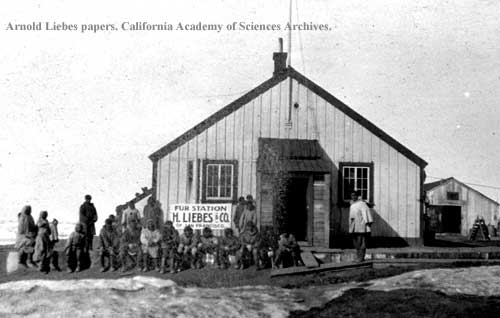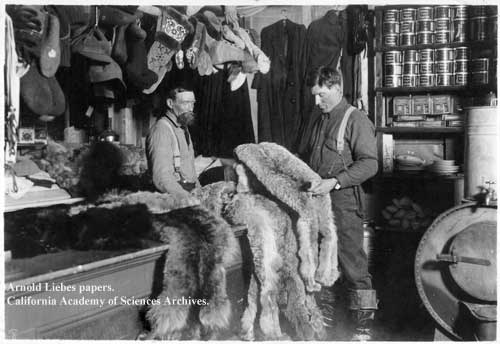The archives staff is working on a large digital image migration project. One of the collections that I worked on is the Arnold Liebes papers. Liebes was a San Francisco furrier who had a trading outpost at Point Barrow, Alaska. Liebes made several trips to Alaska during the 1910s-1920s and took hundreds of photographs documenting his work as well as the lives of the indigenous people he encountered.
 H. Liebes & Co.'s trading station at Pt. Barrow, Alaska.
H. Liebes & Co.'s trading station at Pt. Barrow, Alaska.
 Examining pelts at traders.
Examining pelts at traders.
We digitized five hundred and ninety six Liebes images, and I just finished uniting the metadata with the digital images in our new digital asset management system. While assigning subjects like "hunting", "sealing", "churches", and "ships" to the images, I decided I wanted to learn some more about the named sailing vessels that appear in the photographs. At least three different ships are featured in the photographs including the whaling vessel The Herman, The Arctic, and a ship called The Bear.
 Landing on the ice from The Herman.
Landing on the ice from The Herman.
 The Arctic at Wainwright, Alaska. A.L. Liebes on the left.
The Arctic at Wainwright, Alaska. A.L. Liebes on the left.
I was intrigued by the subject matter of the photos on The Bear. There are photographs of men in military uniforms as well as a "native wedding" and photographs of "a murdered and two witnesses".
 Captain Ballinger and officers of Bear. 1912.
Captain Ballinger and officers of Bear. 1912.
 "Native wedding" on board The Bear at Pt. Hope.
"Native wedding" on board The Bear at Pt. Hope.
This New York Times article, Cutter Gripped by Ice, from September 22, 1913 explained that The Bear was a U.S coast guard ship that made a yearly trip from Nome, Alaska to Point Barrow, Alaska. The Bear had a judge, doctor, and carpenter to dispense justice and medicine to the Inupiak people of Point Barrow. Captain Ballinger, pictured in the ship's crew portrait above, recounts the harrowing tale of the ice bound Bear which was only freed from the ice when the winds changed.
Besides donating his wonderful manuscript and photograph collection to the Academy, Arnold Liebes donated approximately 1,000 objects to our Anthropology department. The collection can be searched through our Anthropology database and includes records and images for carvings, beads & leather work, tools & implements, raw materials, and weaponry. Select "Liebes" in the "collections" field. Liebes also donated items to the Smithsonian including this cormorant parka from St. Lawrence Island, Alaska.
- Danielle Castronovo
Archives & Digital Collections Librarian